Styles: Clarinet Jazz, Big Band
Year: 1998
File: MP3@320K/s
Time: 65:28
Size: 150,5 MB
Art: Front
(2:20) 1. Let's Dance
(3:27) 2. Hunkadola
(3:12) 3. Between The Devil And The Deep
(6:59) 4. King Porter Stomp
(5:17) 5. Moon Glow
(6:08) 6. Stealin' Apples
(2:32) 7. You Turned The Tables On Me
(3:07) 8. Bugle Call Rag
(3:19) 9. Don't Be That Way
(4:00) 10. Memories Of You
(4:11) 11. Restless
(3:16) 12. Get Happy
(5:14) 13. Sometimes I'm Happy
(4:56) 14. China Boy
(3:29) 15. Down South Camp Meetin'
(3:53) 16. Good-Bye
Year: 1998
File: MP3@320K/s
Time: 65:28
Size: 150,5 MB
Art: Front
(2:20) 1. Let's Dance
(3:27) 2. Hunkadola
(3:12) 3. Between The Devil And The Deep
(6:59) 4. King Porter Stomp
(5:17) 5. Moon Glow
(6:08) 6. Stealin' Apples
(2:32) 7. You Turned The Tables On Me
(3:07) 8. Bugle Call Rag
(3:19) 9. Don't Be That Way
(4:00) 10. Memories Of You
(4:11) 11. Restless
(3:16) 12. Get Happy
(5:14) 13. Sometimes I'm Happy
(4:56) 14. China Boy
(3:29) 15. Down South Camp Meetin'
(3:53) 16. Good-Bye
Last Swing Of The Century - Big Band Music of Benny Goodman released on Concord Jazz in 1999 by Benny Goodman Orchestra alumnus, Ken Peplowski, is a heartfelt tribute to The King of Swing and the wonderful arrangements he commissioned in the 1930s and 1940s. Recorded the last night of a 15-concert tour, the CD is the perfect collection of swing standards for those who dance or those that spectate. Ken Peplowski takes 16 essentials, long associated with one of the greatest names in jazz and reinteprets it with veterans of various Benny Goodman orchestras including Randy Sandke, Eddie Bert, Bobby Pring, Ben Aronov, Frank Capp and Jack Stuckey along with other brilliant musicians as Conte Candoli, Frank Vignola, Bob Milikan, Scott Robinson, Joe Romano, Rickey Woodard, and Richard Simon.
Although the cliche that big bands will never come back is somewhat true, Ken Peplowski is the closest that some listeners near the end of this century will remember as bringing the music back to the ‘90s with taste, drive and creativity. Peplowski doesn’t compromise the artistic integrity of his mentor even though each soloist is playing in their own style, with no re-creations of solos from old records! Popular standards such as “Let’s Dance,” “Moon Glow,” “Bugle Call Rag,” “Don’t Be That Way,” and the “King Porter Stomp,” receive some of the very best arrangements they’ve ever had. On “Memories Of You,” Ken spotlights Bobby Pring’s trombone and the young, Frank Vignola’s mellow guitar. He duets with Vignola on one of Goodman’s favorites, “China Boy,” originally recorded with Teddy Wilson and Gene Krupa in 1936.
The clarinet of Ken Peplowski, taken up in honor of Goodman, is brilliant on this hard-swinging set of performances by his orchestra and serves as an excellent example of what can be done and has been done to the keep the music of the Big Band Era fresh and vital. Last Swing Of The Century - Big Band Music of Benny Goodman captures the brilliant essence of Benny Goodman and is ever so essential.
By Paula Edelstein http://www.allaboutjazz.com/last-swing-of-the-century-big-band-music-of-benny-goodman-ken-peplowski-concord-music-group-review-by-paula-edelstein.php
By Paula Edelstein http://www.allaboutjazz.com/last-swing-of-the-century-big-band-music-of-benny-goodman-ken-peplowski-concord-music-group-review-by-paula-edelstein.php
Musicians: Ken Peplowski, clarinet; trumpets; Conte Candoli, Bob Milikan, Randy Sandke; trombones, Eddie Bert, Bobby Pring; saxophones, Jack Stuckey - lead alto, Scott Robinson - tenor, Joe Romano - alto, Rickey Woodard - tenor; rhythm section, Ben Aronov-piano, Frank Vignola - guitar, Richard Simon - bass, Frank Capp - drums.











